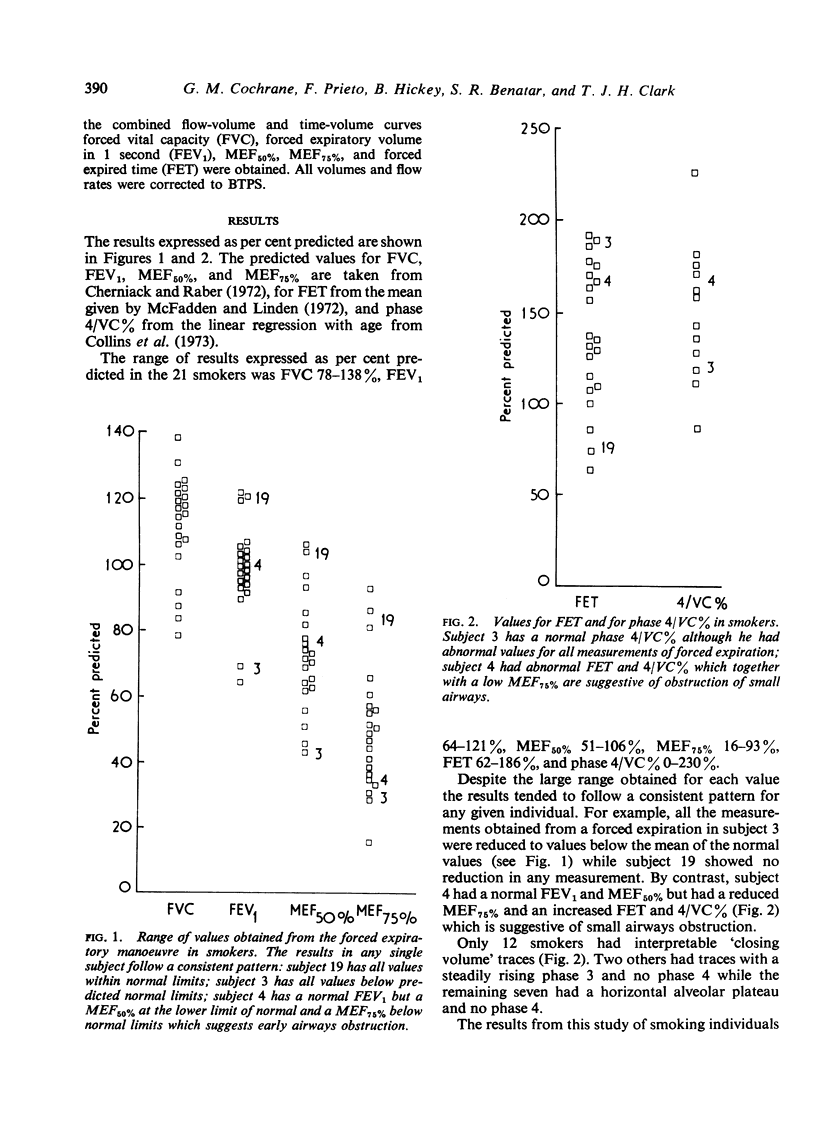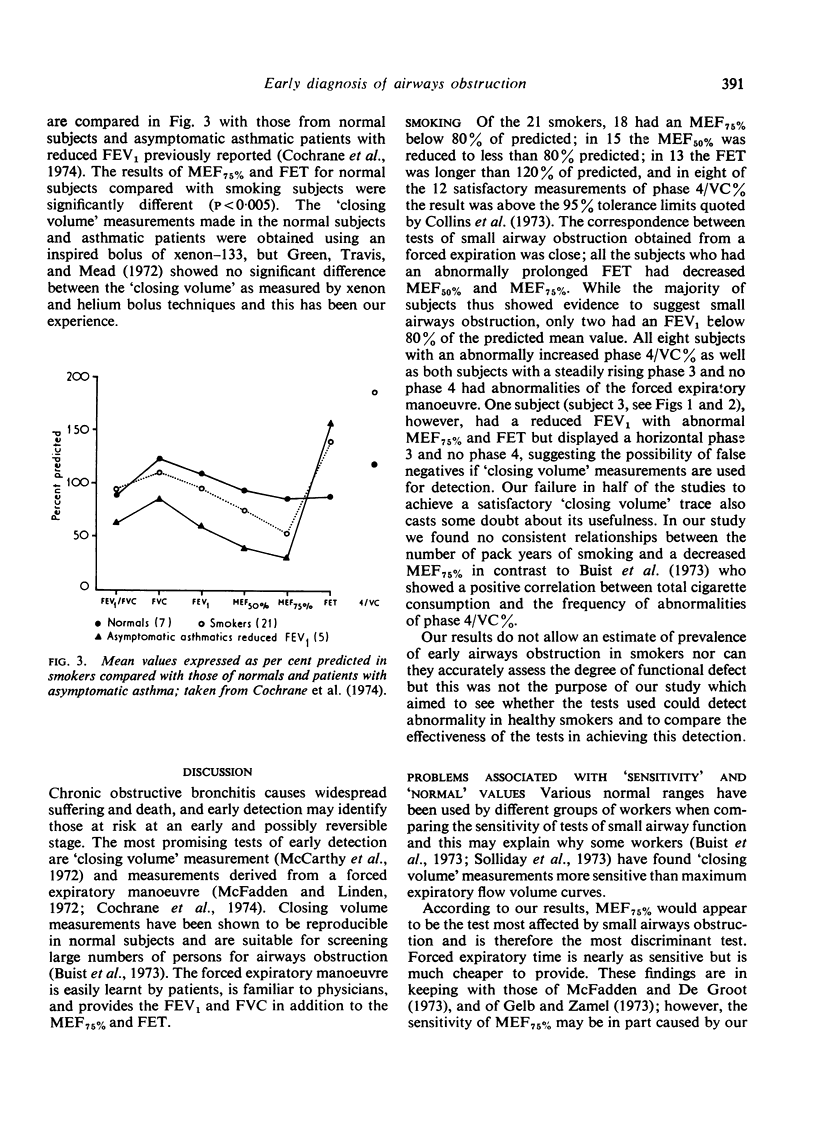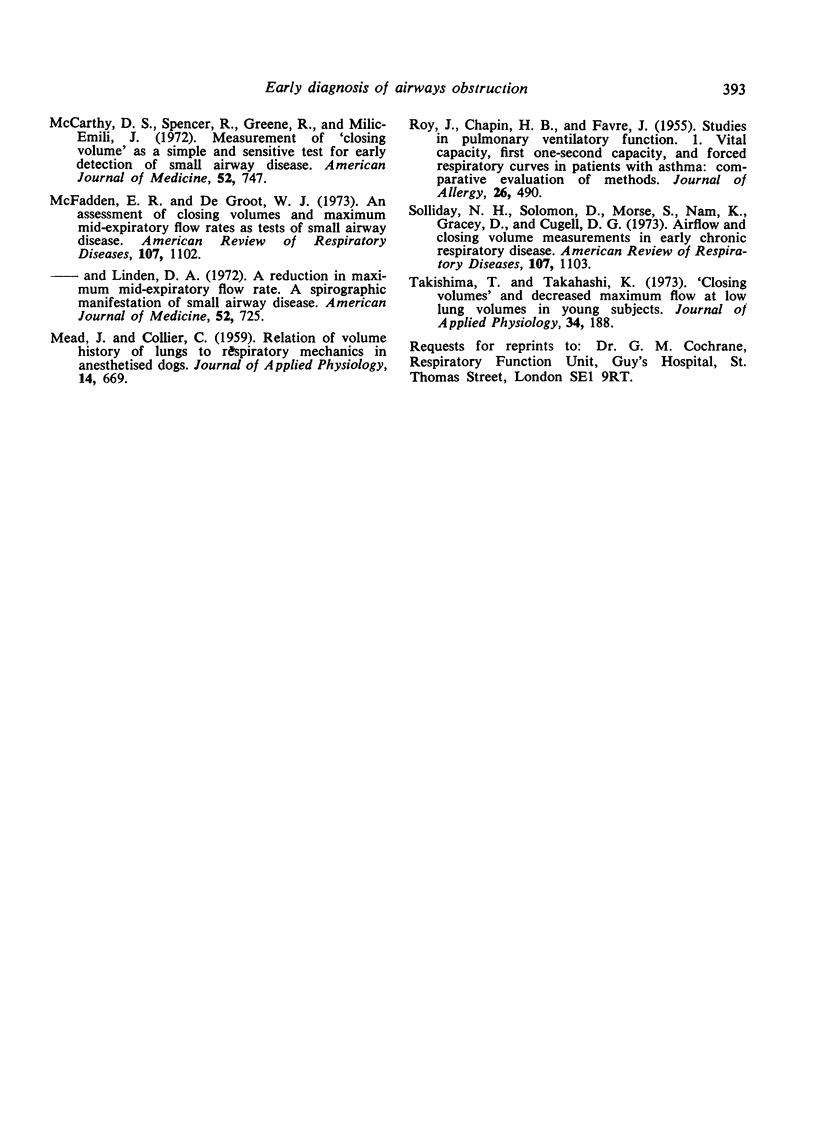Abstract
Cochcrane, G. M., Prieto, F., Hickey, B., Benatar, S. R., and Clark, T. J. H.Thorax, 29, 389-393. Early diagnosis of airways obstruction. Three simple tests, maximum expiratory flow volume curve, maximum expiratory volume time curve and `closing volume', were used to detect early airways obstruction in 21 smokers. A high proportion had abnormal values for MEF75%, MEF50%, and FET (86%, 71%, and 62% respectively) with a relatively normal FEV1. There was a good correlation between tests of small airways obstruction obtained from the forced expiratory manoeuvre. The measurement of `closing volume' (phase 4/VC%) was less satisfactory as there were difficulties with interpretation of the records in half of the studies. We conclude that the forced expiratory manoeuvre can be used to detect early airways obstruction as well as providing FEV1 and vital capacity.
The importance of early diagnosis of airways obstruction is not yet clear and further information is required about its natural history, and its relation to smoking habits and to the more advanced and less reversible stages of airways obstruction. It may be possible to use early detection to prevent the development of disabling chronic obstructive bronchitis.
Full text
PDF




Selected References
These references are in PubMed. This may not be the complete list of references from this article.
- Buist A. S., Van Fleet D. L., Ross B. B. A comparison of conventional spirometric tests and the test of closing volume in an emphysema screening center. Am Rev Respir Dis. 1973 May;107(5):735–743. doi: 10.1164/arrd.1973.107.5.735. [DOI] [PubMed] [Google Scholar]
- Cherniack R. M., Raber M. B. Normal standards for ventilatory function using an automated wedge spirometer. Am Rev Respir Dis. 1972 Jul;106(1):38–46. doi: 10.1164/arrd.1972.106.1.38. [DOI] [PubMed] [Google Scholar]
- Cochrane G. M., Benatar S. R., Davis J., Collins J. V., Clark T. J. Correlation between tests of small airway function. Thorax. 1974 Mar;29(2):172–178. doi: 10.1136/thx.29.2.172. [DOI] [PMC free article] [PubMed] [Google Scholar]
- Collins J. V., Clark T. J., McHardy-Young S., Cochrane G. M., Crawley J. Closing volume in healthy non-smokers. Br J Dis Chest. 1973 Jan;67(1):19–27. doi: 10.1016/0007-0971(73)90003-x. [DOI] [PubMed] [Google Scholar]
- Gelb A. F., Zamel N. Simplified diagnosis of small-airway obstruction. N Engl J Med. 1973 Feb 22;288(8):395–398. doi: 10.1056/NEJM197302222880805. [DOI] [PubMed] [Google Scholar]
- Green M., Mead J., Hoppin F., Wohl M. E. Analysis of the forced expiratory maneuver. Chest. 1973 Apr;63(Suppl):33S–36S. doi: 10.1378/chest.63.4_supplement.33s. [DOI] [PubMed] [Google Scholar]
- Green M., Travis D. M. A simplified closing-volume method suitable for field use. Lancet. 1972 Oct 28;2(7783):905–906. doi: 10.1016/s0140-6736(72)92536-6. [DOI] [PubMed] [Google Scholar]
- Green M., Travis D. M., Mead J. A simple measurement of phase IV ("closing volume") using a critical orifice helium analyzer. J Appl Physiol. 1972 Dec;33(6):827–830. doi: 10.1152/jappl.1972.33.6.827. [DOI] [PubMed] [Google Scholar]
- McCarthy D. S., Spencer R., Greene R., Milic-Emili J. Measurement of "closing volume" as a simple and sensitive test for early detection of small airway disease. Am J Med. 1972 Jun;52(6):747–753. doi: 10.1016/0002-9343(72)90080-0. [DOI] [PubMed] [Google Scholar]
- McFadden E. R., Jr, Linden D. A. A reduction in maximum mid-expiratory flow rate. A spirographic manifestation of small airway disease. Am J Med. 1972 Jun;52(6):725–737. doi: 10.1016/0002-9343(72)90078-2. [DOI] [PubMed] [Google Scholar]
- ROY J., CHAPIN H. B., FAVRE J. Studies in pulmonary ventilatory function. I. Vital capacity, first one-second capacity, and forced respiration curves in patients with asthma; comparative evaluation of methods. J Allergy. 1955 Nov;26(6):490–506. doi: 10.1016/0021-8707(55)90090-3. [DOI] [PubMed] [Google Scholar]
- Takishima T., Takahashi K. "Closing volumes" and decreased maximum flow at low lung volumes in young subjects. J Appl Physiol. 1973 Feb;34(2):188–193. doi: 10.1152/jappl.1973.34.2.188. [DOI] [PubMed] [Google Scholar]


